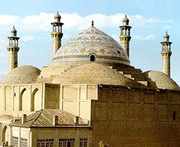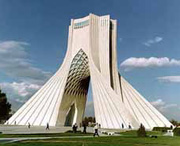伊朗首都-德黑兰
(单词翻译:单击)
Tehran (Iran)
 Iran is not blessed with one of the world's loveliest capitals. Pollution, traffic snarls1, chronic2 overcrowding(长期过度拥挤)and a lack of responsible planning have all helped to make Tehran a metropolis3 that even the most effusive4 travel agent would have difficulty praising. Iran is not blessed with one of the world's loveliest capitals. Pollution, traffic snarls1, chronic2 overcrowding(长期过度拥挤)and a lack of responsible planning have all helped to make Tehran a metropolis3 that even the most effusive4 travel agent would have difficulty praising.
If you're expecting an exotic(异国请调的)crossroads steeped in oriental splendour, you'll be sadly disappointed. The main sights are spread out, but the hotels are good, the variety of restaurants is impressive, the facilities are far ahead of those anywhere in the provinces, and the Tehranis are friendly. There is no real central area, though many budget travellers base themselves near Emam Khomeini Square in the less appealing south of the city, where there's cheap accommodation, fine kebab(烤肉串)and good access to bus and train transport. Getting lost in Tehran is easy. If you need landmarks5, the Alborz mountains, known as the 'North Star' of Tehran, are to the north; and the huge telephone office at Emam Khomeini Square dominates inner southern Tehran. Fortunately, most streets that travellers are likely to take are signposted(给……加路标)in English. Other than that, many streets, such as those around the Tehran Bazaar6(德黑兰集市), have no signposts at all. The best times to visit are during late spring (mid-April to early June) and autumn (late September to early November). Avoid coming in winter and the Iranian New Year (about 21 March) and two weeks after it. Many restaurants close between dawn and dusk during the month of Ramazan(斋月).
From the early 1920s, the city was extensively modernised on a grid10 system, and this period marked the start of phenomenal population growth and uncontrolled urban development. An educated and cosmpolitan middle class elite11, with an open attitude towards Western influence, flourished under the Shah, but the growth of the city began a trickle12 of poor, rural migrants that soon turned into a flood. The depopulation(居民减少)of the surrounding regions continues to this day as the rural poor continue to stream into Tehran in ever greater numbers. This migration13 has put the city's infrastructure14 under enormous pressures. In 1930 the population was 300,000; in 2001 it was estimated to be 12 million. These pressures often translate into popular revolt, hence Tehran's central role in the Islamic Revolution of 1979 and in more recent protests against the clerical monopolisation of political power. |
 收听单词发音
收听单词发音
1
snarls

|
|
| n.(动物的)龇牙低吼( snarl的名词复数 );愤怒叫嚷(声);咆哮(声);疼痛叫声v.(指狗)吠,嗥叫, (人)咆哮( snarl的第三人称单数 );咆哮着说,厉声地说 | |
参考例句: |
|
|
|
2
chronic

|
|
| adj.(疾病)长期未愈的,慢性的;极坏的 | |
参考例句: |
|
|
|
3
metropolis

|
|
| n.首府;大城市 | |
参考例句: |
|
|
|
4
effusive

|
|
| adj.热情洋溢的;感情(过多)流露的 | |
参考例句: |
|
|
|
5
landmarks

|
|
| n.陆标( landmark的名词复数 );目标;(标志重要阶段的)里程碑 ~ (in sth);有历史意义的建筑物(或遗址) | |
参考例句: |
|
|
|
6
bazaar

|
|
| n.集市,商店集中区 | |
参考例句: |
|
|
|
7
neolithic

|
|
| adj.新石器时代的 | |
参考例句: |
|
|
|
8
prominence

|
|
| n.突出;显著;杰出;重要 | |
参考例句: |
|
|
|
9
enchanting

|
|
| a.讨人喜欢的 | |
参考例句: |
|
|
|
10
grid

|
|
| n.高压输电线路网;地图坐标方格;格栅 | |
参考例句: |
|
|
|
11
elite

|
|
| n.精英阶层;实力集团;adj.杰出的,卓越的 | |
参考例句: |
|
|
|
12
trickle

|
|
| vi.淌,滴,流出,慢慢移动,逐渐消散 | |
参考例句: |
|
|
|
13
migration

|
|
| n.迁移,移居,(鸟类等的)迁徙 | |
参考例句: |
|
|
|
14
infrastructure

|
|
| n.下部构造,下部组织,基础结构,基础设施 | |
参考例句: |
|
|
|
- 上一篇:火奴鲁鲁(即“檀香山”)
- 下一篇:黎巴嫩首都-贝鲁特

 Human settlement of the region dates from
Human settlement of the region dates from 


